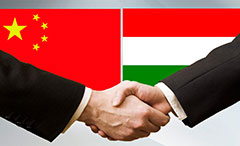3 final CEE countries align with Belt, Road Initiative
2017-11-29
China Daily
 Premier Li Keqiang and Hungarian Prime Minister Viktor Orban (center, right) talk with entrepreneurs after the opening of the seventh China and the Central and Eastern European Countries Economic and Trade Forum in Budapest, Hungary, on Nov 27.
Premier Li Keqiang and Hungarian Prime Minister Viktor Orban (center, right) talk with entrepreneurs after the opening of the seventh China and the Central and Eastern European Countries Economic and Trade Forum in Budapest, Hungary, on Nov 27.
China has signed memorandums of understanding with Estonia, Lithuania and Slovenia to promote the Belt and Road Initiative, signaling that all 16 Central and Eastern European countries have agreed to align with the initiative.
Last November, Latvia signed such a document during the fifth China-CEEC leader’s meeting. Hungary became the first in Europe to sign to participate in the initiative in June 2015.
The initiative, proposed by President Xi Jinping in 2013, comprises the Silk Road Economic Belt and the 21st Century Maritime Silk Road. It will create a vast network of trade and infrastructure along the ancient Silk Road routes.
The memorandums were among more than 10 agreements signed between China and CEE nations on Nov 27 in Budapest, the Hungarian capital. The signings were witnessed by Premier Li Keqiang and other leaders after the sixth Meeting of Heads of Government of China-Central and Eastern European Countries. The documents covered areas such as connectivity, production capacity cooperation, infrastructure and finance.
At the meeting, the Premier called for promoting bilateral trade, connectivity, innovation cooperation, financial cooperation and people-to-people exchanges.
Premier Li called on all 17 countries to accelerate the process of key projects on connectivity, promoting links on land, sea, air and via the internet. More measures should be released to facilitate customs clearance, and China would like to see more rail lines and direct flights between China and Europe, he said. A logistics center will be set up in the CEE region, he said.
The Premier also suggested innovation cooperation focusing on production capacity, energy, logistics and agriculture and said enterprises from CEE nations are welcome to participate in the Made in China strategy.
According to the General Administration of Customs, bilateral trade between China and CEE nations hit $58.6 billion last year, a year-on-year increase of 4.3 percent. The volume increased to $49.1 billion in the first nine months this year, up by 14.1 percent compared with the same period last year.
Chinese investment in CEE nations has exceeded $9 billion, while the 16 CEE countries have invested more than $1.4 billion in China, the world’s second-largest economy. Bilateral cooperation has made achievements in transport, energy and production capacity. About 20 projects have been completed or are under construction, with the Hungary-Serbia Railway as the most eye-catching one.
As the chair of this year’s China-CEEC meeting, Hungarian Prime Minister Viktor Orban said the 16 CEE nations take cooperation with China as an opportunity and will participate in the Belt and Road Initiative. He said a better environment will be created for Chinese enterprises to make their investments and promote a long-term development of China-CEEC exchanges.
Feng Zhongping, vice-president of the China Institutes of Contemporary International Relations, said that all CEE countries are along the route of the Silk Road Economic Belt and their signing of the memorandums marked that the cooperation between the two sides has entered into a new stage and will make more progress.
“China-CEEC cooperation mainly focuses on trade and infrastructure, and financing is a key to solving the problem of funding for infrastructure projects,” Feng said. “Central and Eastern Europe can also be a gateway for China to enter the larger market of the European Union.”



